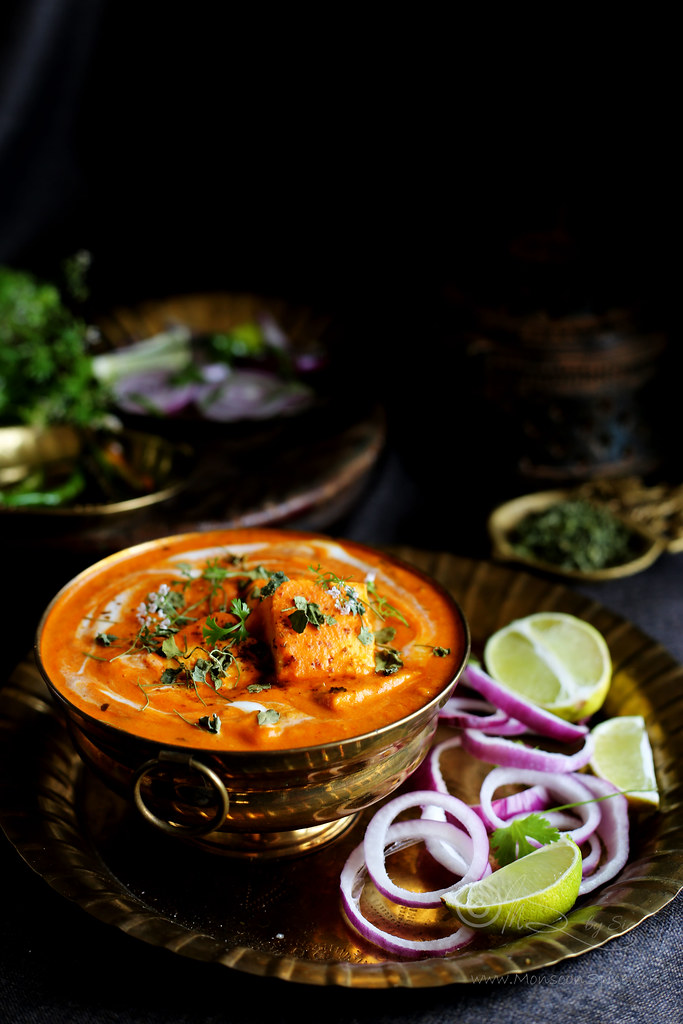
Learn how to make Shahi Paneer ~ Indian cottage cheese in creamy tomato, almond and cashew nut gravy
India is the largest producer of milk and it is no surprise that we Indians love milk and milk produce. Starting our day with strong milky coffee or tea, we integrate milk and milk products in various recipes. It may even sound little strange when we say our meal is incomplete, especially for a South Indian, without a glass of yogurt or buttermilk, either mixed with rice and pickle at the end of a meal or spiced with few green chillies, cumin powder etc or sweetened with sugar. Milk, yogurt, buttermilk, ghee, butter and cream are part and parcel of Indian meals. And there is one more milk product which we all love and quite crazy about! It’s
Paneer or Indian cottage cheese.
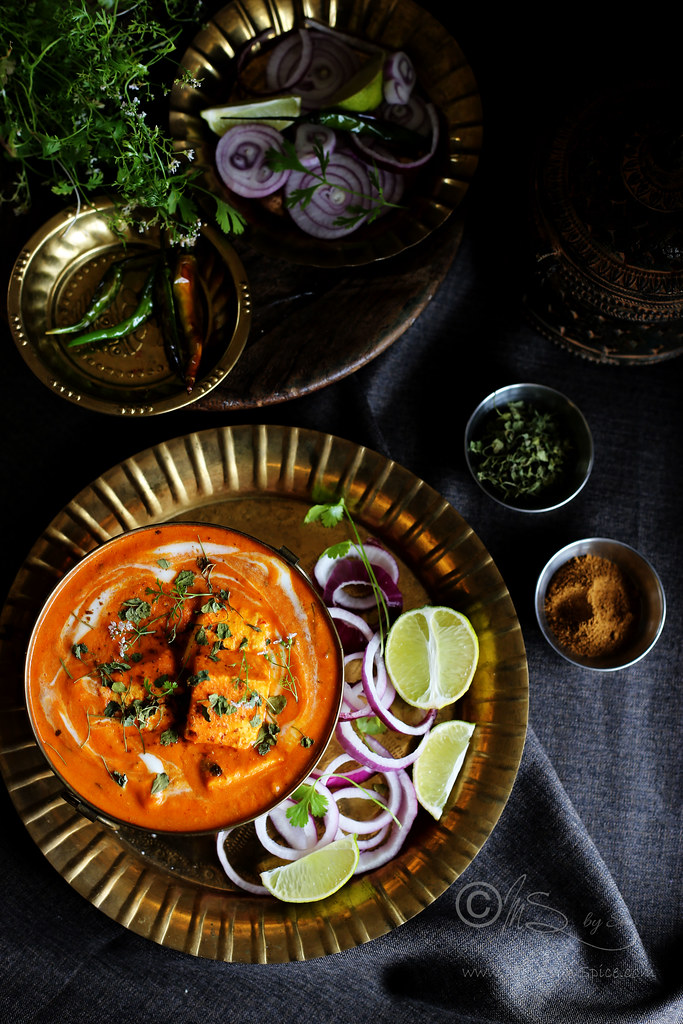
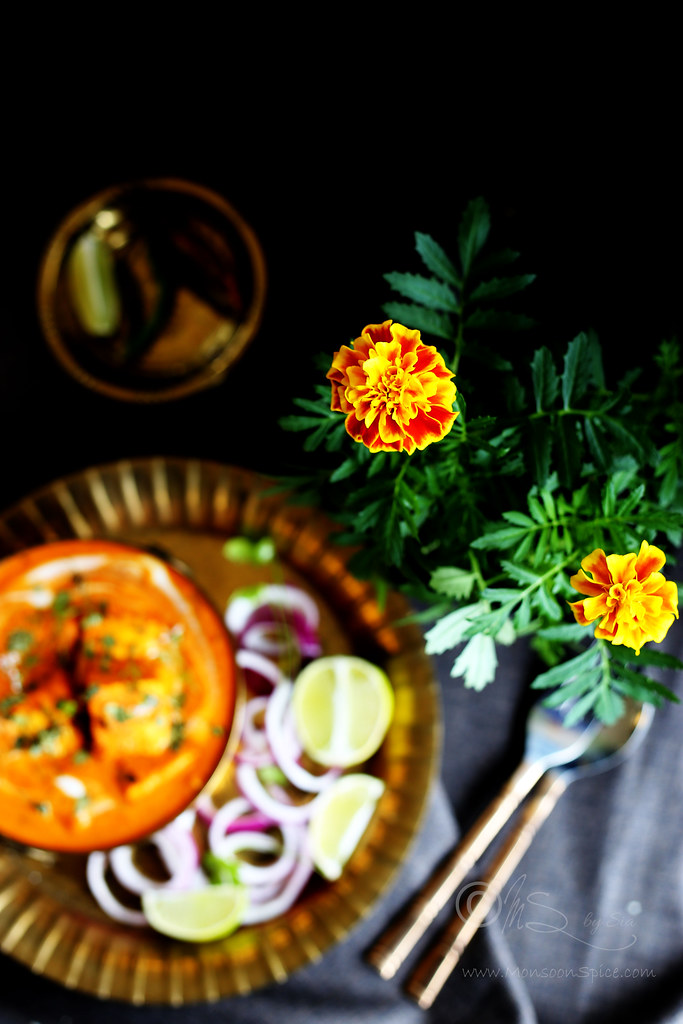
Paneer (pronounced pa-nir) is a fresh cheese used in Indian subcontinent for centuries. When I say cheese, it is acid-set, unsalted, non-melting firmer cheese. It is also a fresh cheese, meaning you can make it and eat it right away and it requires no aging or culturing. It required just 2 ingredients; milk (preferably full fat milk) and lemon juice or vinegar and is very easy to make at home by curdling heated milk with lemon juice or vinegar and the acidity in the lemon juice or vinegar causes the milk to separate into curds/milk solid and whey. The whey is separated with a help of a strainer lined with cheese cloth to collect the milk sold. This crumbly and moist form is called ‘Chhena’ and is used in making many sweets like rasgulla, ras malai, sandesh etc in Easten Indian and Bangladesh. When the chhena is pressed to remove excess water by pressing doen heavy object on top, we get the solid paneer block which is then cut into cubes and is ready for cooking straight away.
Paneer is a versatile and a very popular ingredient used mainly as a star ingredient for many North Indian curries. With its fairly mild, milky flavour and dense crumbly texture which doesn’t melt like other cheese, its best when paired with strong and spicy flavours like in classic Indian curries or dishes like
Palak Paneer (spinach based curry),
Achari Paneer (tomato base with Indian pickling spices),
Matar Paneer (peas and tomato),
Paneer Jalfrezi (tossed with bell pepper in lightly spiced tomato paste),
Paneer Kurma (lightly spiced yogurt based dish),
Kadai Paneer (whole spices and tomato paste),
Paneer Kofta (deep fried paneer dumplings in creamy gravy),
Paneer Tikka Masala (marinated paneer with vegetables) and many other Paneer curries. It also makes a wonderful filling for Samosa,
Paratha and even can be mixed with dough to make extremely nutritious rotis.
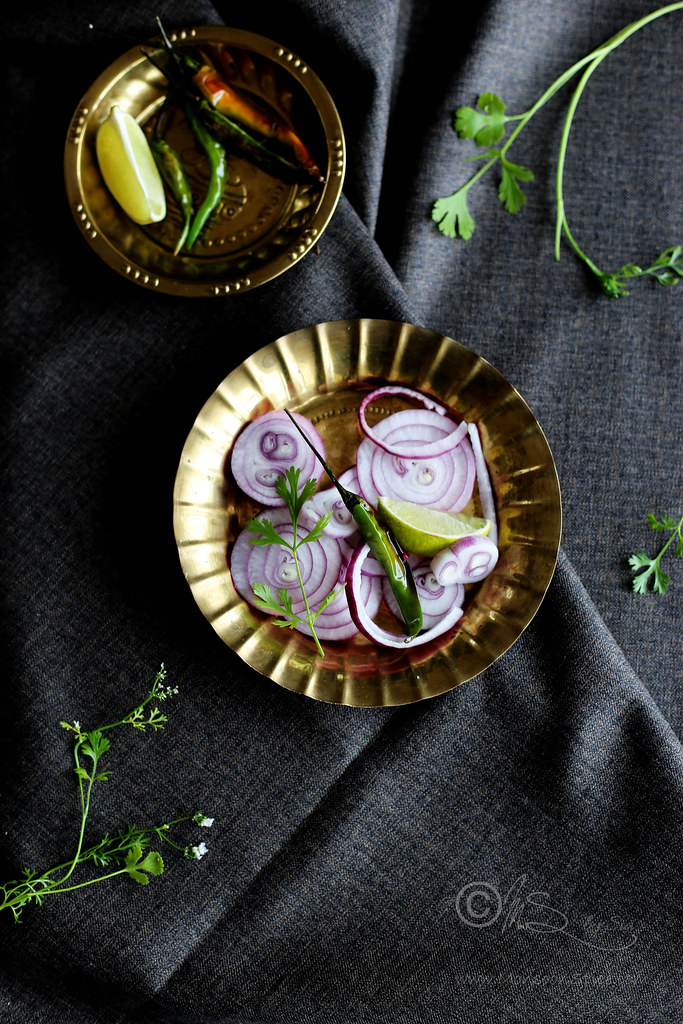
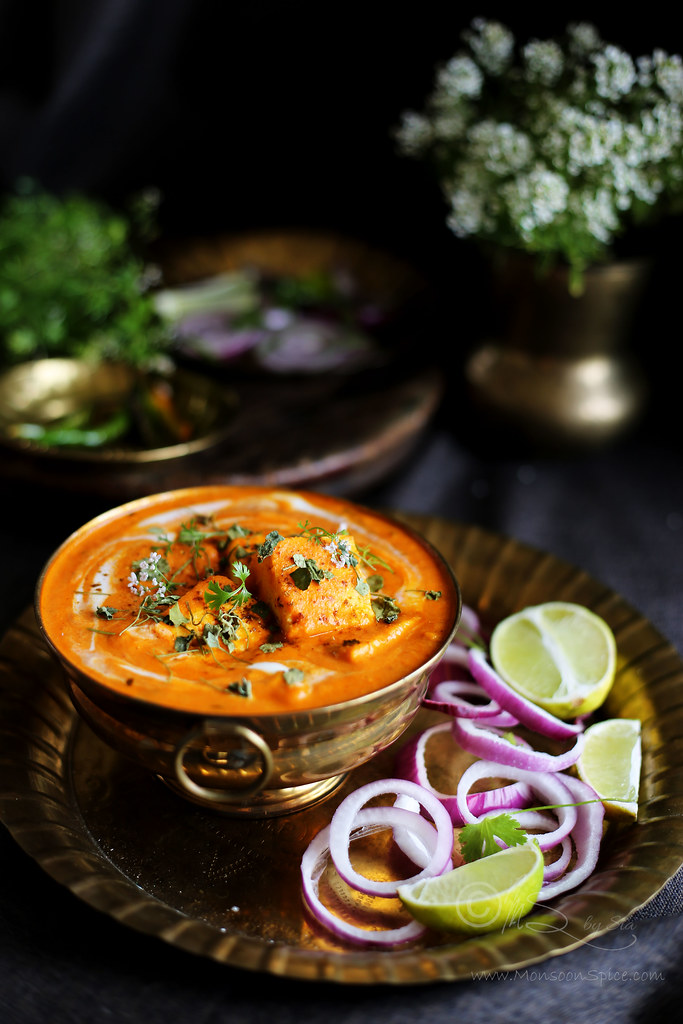
My quest to learn more about the origin and history of Paneer left me wanting to know more about it. As per
Wikipedia, the word “Paneer” is of Persian origin. The Turkish word peynir, the Persian, Armenian and the Azerbaijani word panir, all derived from ‘paneer’ referes to any type of cheese. However the origin of paneer is still debatable as Vedic Indian, Afghan-Iranian and Portuguese-Bengali origins have been proposed for paneer. The wiki further explains that the Vedic literature refers to a substance that is interpreted by some authors as a form of paneer. While according to Arthur Berriedale Keith, a Scottish constitutional lawyer, scholar of Sanskrit and Indologist, a kind of cheese is “perhaps referred to” in Rigveda, author Otto Schrader, a German philologist, believes that the Rigveda only mentions “a skin of sour milk, not cheese in the proper sense”. According to K.T. Acharya, an eminent food historian, the acidulation of milk was a taboo in the ancient Indo-Aryan culture, pointing to the legends about Lord Krishna make several references to milk, butter, ghee and yogurt, but do not mention sour milk cheese.
According to Wiki and
Quora, based on the texts such as Charaka Samhita (Compendium of Caraka, an ancient Sanskrit text on Ayurveda), B. N Mathur wrote that the earliest evidence of a heat-acid coagulated milk product in India can be traced to 75-300 CE, in the Kushan-Satavahana era. Sunil Kumar etal. interpret this product as the present-day paneer. According to them, paneer is indigenous to north-western part of South Asia, and was introduced in India by Afghan and Iranian travellers in the 16th century and was made from goat or sheep rennet. These cheeses were the predecessors of modern paneer which requires no animal products, such as rennet, for coagulation making it one of the important sources of protein for lacto-vegetarians D.R. Ghodekar of India's National Dairy Research Institute also believed that paneer was introduced into India by Afghan and Iranian invaders. According to writers such as K.T. Achaya, Andrea S. Wiley and Pat Chapman, the Portuguese introduced the technique of "breaking" milk with acid to Bengal in the 17th century. Thus, Indian acid-set cheeses such as paneer and chhena were first prepared in Bengal, under Portuguese influence.
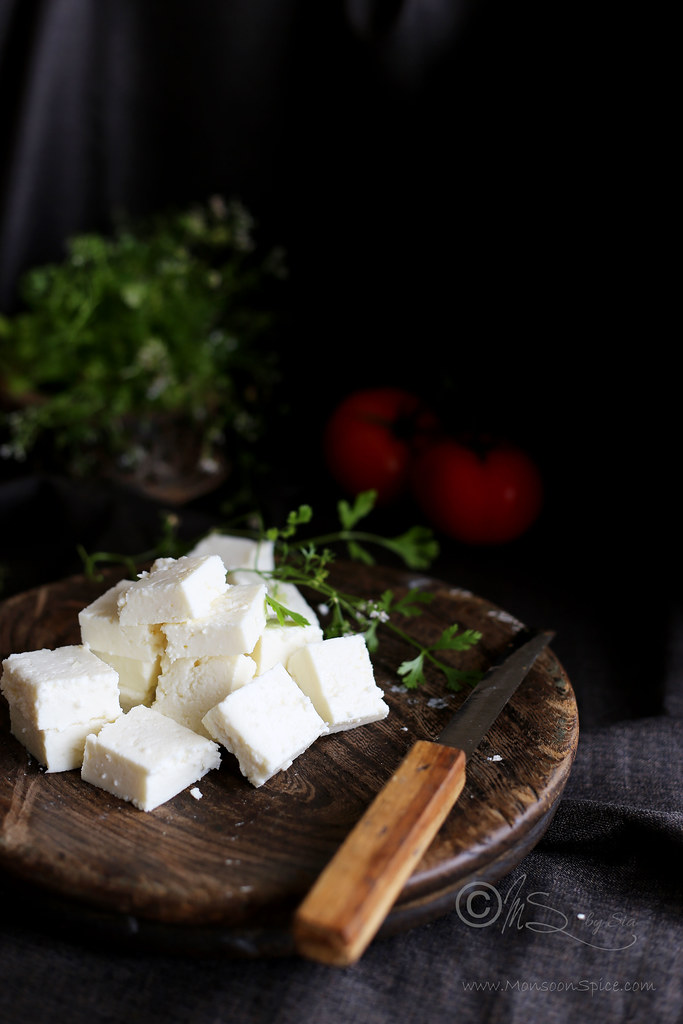
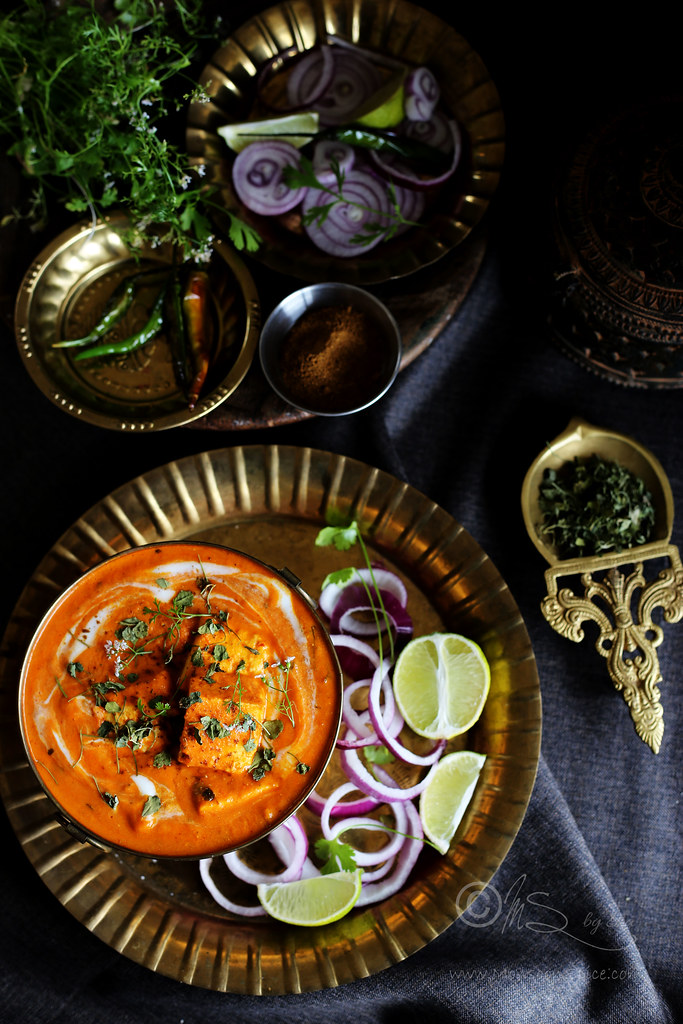
With such interesting history and packed with nutrition,
Paneer is definitely one of the most popular ingredient in Indian cuisine, especially for lacto-vegetarians. Apart from many other curries mentioned above, there is one more dish that is quite popular in Indian restaurants often served with some type of Indian breads such as poori, naan, tandoori roti or rumali roti. The dish is called
Shahi Paneer where the word ‘Shahi’ refers to royal in reference to the imperial court. The dish
Shahi Paneer is made by cooking the fresh paneer in thick and creamy gravy of tomatoes, fresh cream, nuts and spices.
The first step in the preparation of Shahi Paneer is to make fresh paneer by adding an acidic liquid (I prefer lime juice to vinegar) to boiled hot milk. The chemical reaction causes the curds or the milk solid and whey to separate in a couple of minutes. This is then collected in sieve lined with cheese cloth to separate the whey from the curds and squeezed to remove as much moisture as possible before pressing it down under a weight for couple of hours to get a block of paneer which can be cut into cubes and used right away in curries. Don’t discard this whey as it contains very high nutrients and this liquid can be used to make dough or in soups or stews. If you are short of time and don’t have fresh homemade paneer, you can always use store brought one for convenience.
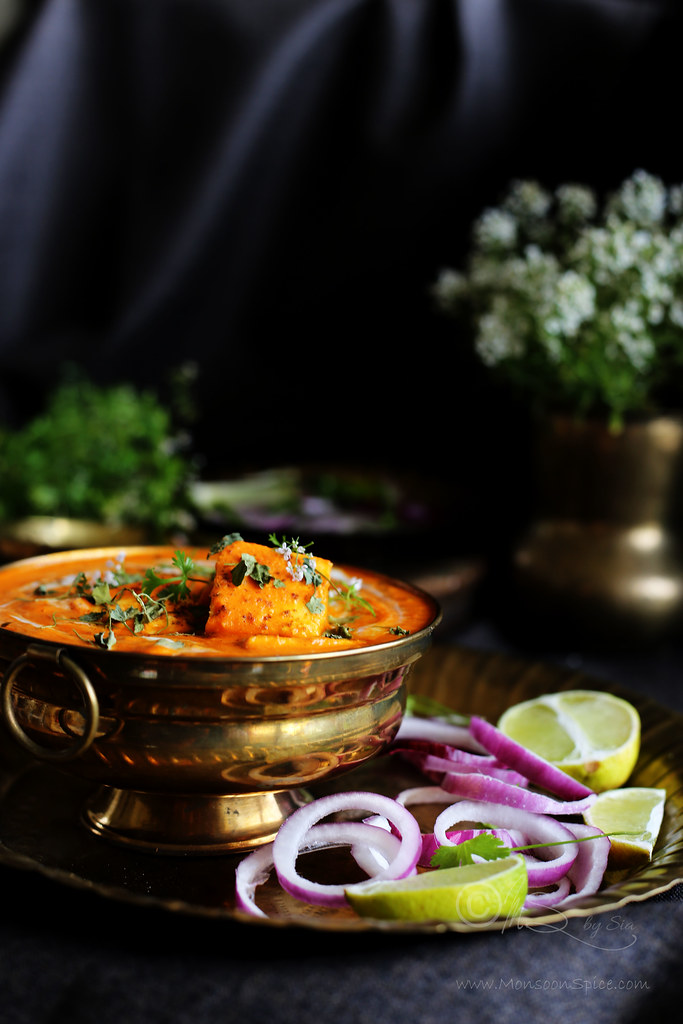
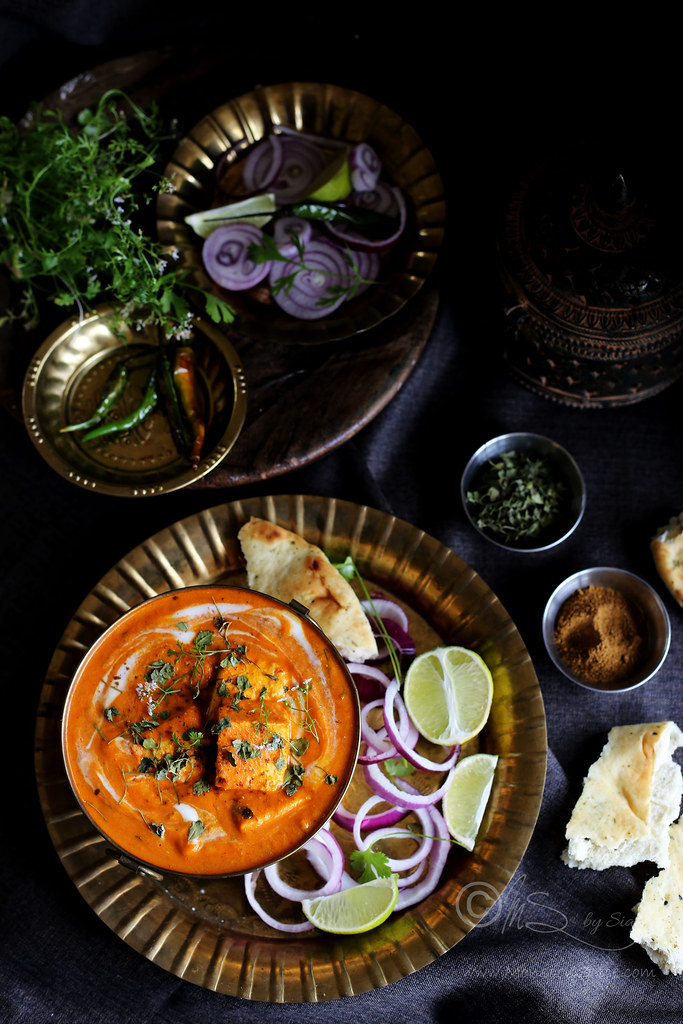
Once the paneer is ready, proceed to make the gravy base for the curry. Now there are two versions of this, one that uses tomatoes and the second without tomatoes. Personally I prefer tomatoes in gravy as they impart mellow sweet and sour when combined with other ingredients making the dish more flavoursome! To make the spice base, first the onions and tomatoes are lightly fried in little oil or ghee and then cooked with whole Kashmiri chillies and dry nuts in little water for couple of minutes. This is then ground to smooth paste to get the gravy base. Then we proceed to make the tadka of whole spices with ginger-garlic paste and tomato puree or paste before adding the ground nut paste. To this then we add fresh cream or if you want to reduce the calorie like me, add whisked full fat yogurt. This makes rich and velvety smooth base gravy truly fit for the royals.
Finally the star ingredient of this dish paneer is added to the gravy and is simmered for couple of minutes so that the paneer absorbs the rich aroma and flavour of harmonious blend of spices. If using fresh paneer, just add the cubes directly to the gravy and if using store brought one, you can lightly pan fry the cubes with little oil or ghee until it turns golden brown on both sides. The whole cooking from start to end doesn’t take more than 40-45 minutes. Just make sure that your Indian pantry is nicely stocked with the spices and ingredients listed below in the recipe and you will end up cooking this Shahi Paneer again and again for your loved ones.
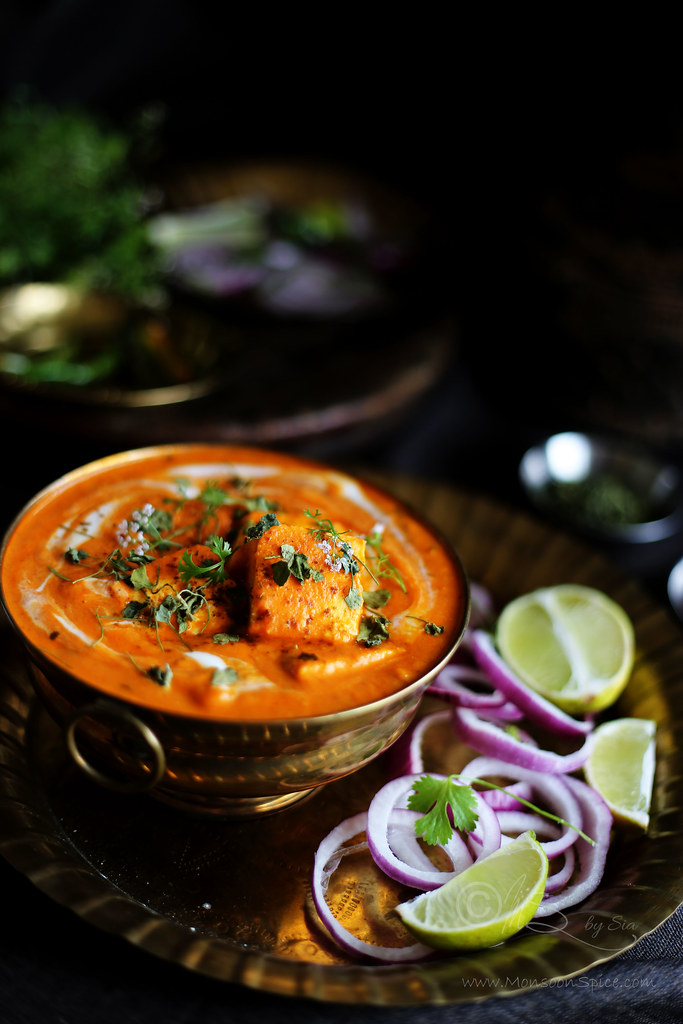
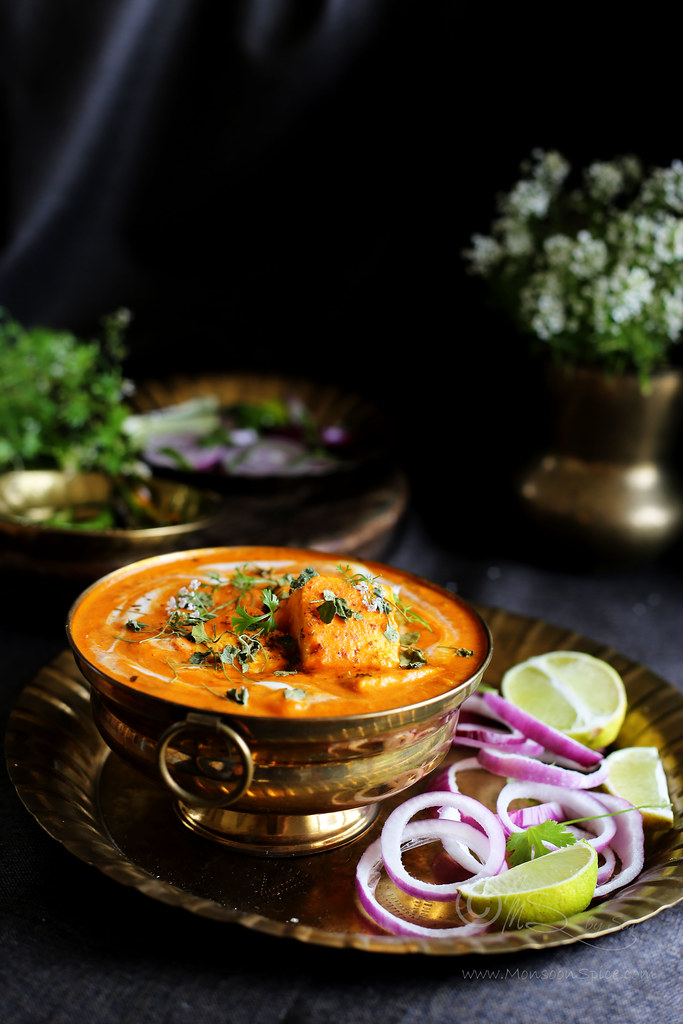
Shahi Paneer (Indian cottage cheese in creamy tomato, almond and cashew nut gravy)
Prep Time: 10 mins
Cooking Time: 30-35 mins
Spice Level: Low to Medium
Recipe Level: Easy/Beginner
Serves: 5-6 people
Shelf Life: Best served fresh but can be refrigerated for 2-3 days
Serving Suggestion: With any
Indian flat breads (
Whole Wheat Naan or
Butter Naan or with any
stuffed parathas) or plain/flavoured
Basmati rice
Ingredients:
200-250 gms Paneer, cut into 1 inch squares of 1 cm thickness
2 tsp Ginger-Garlic Paste
1 tbsp thick Tomato Paste or ¼ cup Tomato Puree
¾ cup thick Yogurt, whisked
Salt to taste
1 – 1½ tbsp. Oil or Ghee
For Almond-Cashew Nut Paste:
1 medium Onion, finely chopped
3 large or 4 medium Tomatoes, chopped
12 Almonds
12 Whole Cashew Nuts
3-4 Dry Kashmiri Chillies or Byadagi Chilli (Read notes)
½ tbsp. Oil or Ghee
2 tsp Sugar or Jaggery (I used jaggery which is unrefined cane sugar)
Spices Used:
1 inch Cinnamon or Cassia Stick
1 Bay Leaf
4 Cloves
4 Green Cardamoms
1 tbsp Kasuri Methi/Dry Fenugreek Leaves
½ tsp Garam Masala (Adjust as per taste)
½ tsp Kitchen King Masala (Optional, but recommended)
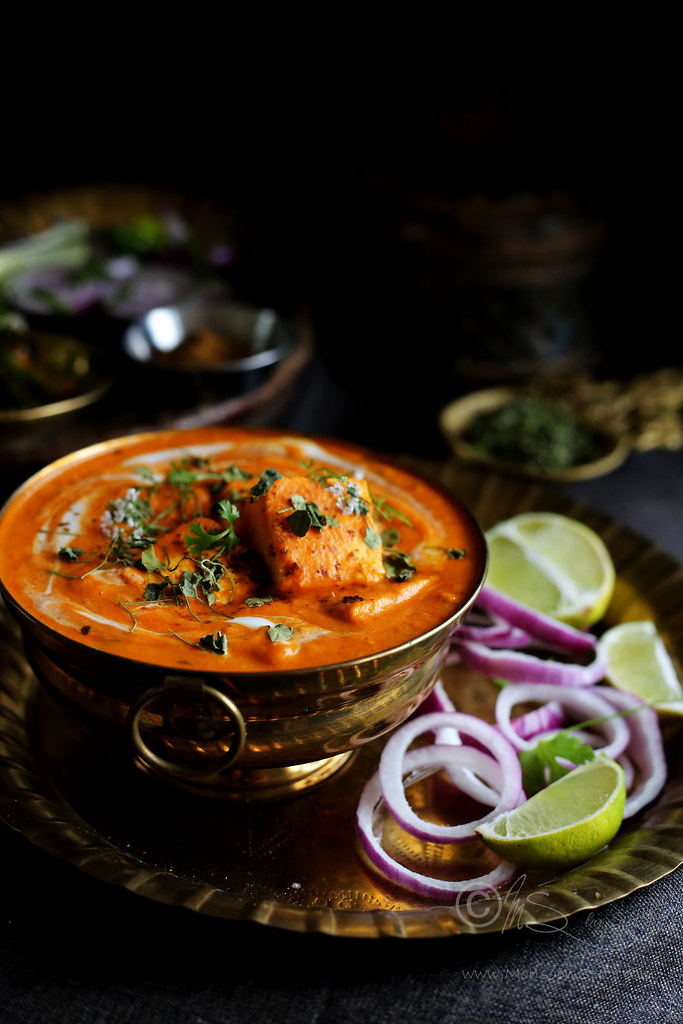 Method:
Preparation:
Method:
Preparation:
- Cut the paneer into cubes and keep them aside. If needed, you can pan fry the paneer pieces in little oil or ghee until it turns golden brown on both sides. Keep the fried paneer pieces in a bowl of hot water to keep them soft and crumbly.
- Chop the onion and tomatoes and make fresh ginger-garlic paste by crushing them with a help of a pestle and mortar.
Prepare the almond and cashew nuts paste:
- Heat ½ tbsp. of oil or ghee in a pan and add chopped onions, tomatoes and sugar or jaggery. Sauté them on medium flame for a minute. Mix in ¼ cup of water and bring the water to boil.
- To this add almonds, cashew nuts and Kashmiri chillies. Cover the pan and cook for 2-3 minutes. Turn off the flame and let the mixture cool down to room temperature before grinding it to smooth paste. Keep it aside until needed.
Proceed to cook:
- Heat 1-1½ tbsp. of oil or ghee in a pan and cinnamon, cloves, cardamoms and ay leaves. Stir fry for a minute before adding ginger-garlic paste and fry it until the raw smell disappears, about a minute or two.
- Mix in tomato puree or tomato pasted dissolved in 3 tbsp water and stir well. Cook for 2 minutes.
- Next add ground almond-cashew nut paste to the gravy and mix them well. Add half of kasuri methi crushed with fingers and salt to taste. Cook uncovered for 4-5 mins on medium flame.
- Remove the pan from heat and mix in whisked yogurt or fresh cream and stir well. Bring the pan back on heat and simmer the gravy for 4-5 minutes. Add about ½ cup or more of water if you find the gravy too thick to adjust the consistency. Add salt to taste and mix well.
- Next add the paneer, garam masala, kitchen king masala if using and remaining kasuri methi and let the gravy simmer for another 5-6 minutes. Turn off the flame and let it rest for 10 minutes to allow the flavours to develop.
- Serve this delicious, velvety smooth Shahi Paneer with any Indian flat breads or flavoured basmati rice and enjoy!
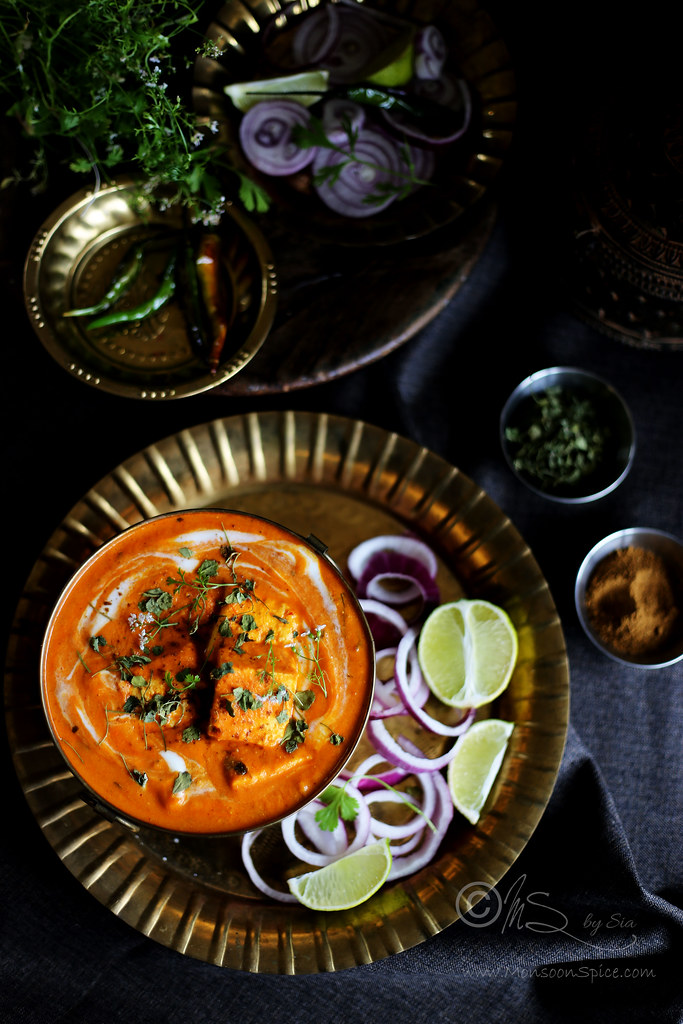
Sia’s Notes:
- If using fresh paneer, just add the cubes directly to the gravy and if using store brought one, you can lightly pan fry the cubes with little oil or ghee until it turns golden brown on both sides.
- This is a mild curry as we are using Kashmiri chillies. If you prefer spicy curry, use hot chillies instead of Kashmiri chillies.














A beautiful, fragrant and mouthwatering dish! Really fabulous.
ReplyDeleteI absolutely have to get my hands on paneer (or make my own).
Cheers,
Rosa
Thank you, Rosa! And yes, please do get hold of some paneer and see how you like it. :)
DeleteNothing can beat the taste of fresh paneer, the dish looks so beautiful:). As I have said before you always inspire me to try something new, I have to try my hand on making fresh paneer, always feel the store bought ones have a rubbery texture, Thank you Sia for this dish !!
ReplyDeleteShilpa, you are absolutely right about the difference between the homemade and store bought Paneer. It took me 5+ years to finally convince myself to try making it at home as I always felt its too time consuming and difficult to make. But it was really simple to make at home and since then I have never looked back. I will try to post a recipe on how to make it at home.
DeleteLooks sooo delicious Sia! oh my! the clicks !! simple stunning!! loved it!
ReplyDeleteYou are kind :) Thanks a lot!
DeleteHello Sia,
ReplyDeleteMy comments will first concentrate on the writing content and then meander to the recipe. As you said sisters, just like you before I cook a recipe I like to read about its ingredients on Wikipedia and Quora. I am very intrigued by food and its origins. Somehow we never grew new roots right, we are branching out but the roots speak of our past. After reading so many articles about the various food brought to India by the Afghans I am convinced that they were the food pioneers in their era. Sadly, It talks a very different story in wartime. I throughly enjoyed the history bit.
Next, the way you described the process of reaching your cooking process and paraphrasing each step of your cooking is also quite interesting and shows the effort you take in guiding the reader. I should invest in this skills.
The photographs and the colour of the Shahi Paneer completely do justice to its rich legacy.
Lots of love!!
Pallavi, I too am intrigued by the the origins of food and it's history. It makes such a compelling study and the more I dig into it, the more exciting it gets. Although there is a great influence from Persian and Afghan food and culture in North India and Central India, it's a different story in South India where there is some influence from the Arab world and European food due to all that trading culture which dates backs to centuries! Persians food influence, mainly during Mughal era has given us very rich food with assorted spices and flavours, but the south Indian food fascinatingly still has strong root dating back to millenniums. I love, love reading food histories and learning about the food that I cook and eat. Its a fascinating world :)
DeleteAbout recipe writing, my main goal is to make Indian food as approachable as possible and so I try little hard on that part to make it simple by breaking it down to easy to follow steps/instructions. Thank you for stopping by and leaving such positive feedback. :)
I like these photos..class apart .I think this is what makes ur blog distinguish able
ReplyDeleteThank you for such generous compliments :)
DeleteMade and loved this. Thanks!
ReplyDeletestunning clicks!! loved it !!
ReplyDeleteHi Sia, I love all your recipes! I have been wanting to make paneer makhani or shahi paneer but almost all recipes require cashews. My daughter is allergic to all nuts and also sesame. Do you have any suggestions on how to modify the recipe? Should I simply just eliminate them from the recipe? Any ideas on substitutes? Thanks for such wonderful recipes!
ReplyDeleteHi Anika, you can skip the nuts entirely. You can also use some fresh cream if you like creamier curries. Hope this helps.
Delete